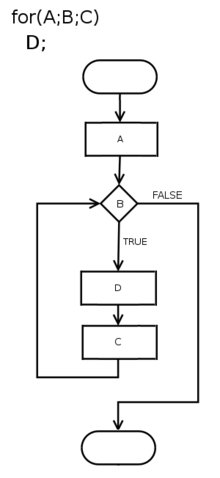For迴圈
for迴圈(英語:for loop)在電腦科學是一種程式語言的迭代陳述,能夠讓程式碼反覆的執行。

它跟其他的迴圈,如while迴圈,最大的不同,是它擁有一個迴圈計數器,或是迴圈變數。這使得for迴圈能夠知道在迭代過程中的執行順序。
for 迴圈的種類
編輯傳統的 for 迴圈 for-loops
編輯C語言中傳統的for-loop包含三個部分:初始化、條件、遞增,這三個部分都是可有可無的。[1]
- 以Java為例:
for (INITIALIZATION; CONDITION; AFTERTHOUGHT)
{
// Code for the for-loop's body goes here.
}
初始化是宣告(或者賦值)任何需要的變數的動作。如果你要使用多個變數,則變數的種類要一致。條件的部分則是檢查是否離開這個迴圈,也就是讓程式碼往下執行。如果條件判斷為假,則離開迴圈。遞增在每跑一次迴圈都會重複執行一次。
- 在此以Java為例:
for (int i=0; i<100; i++) // Prints the numbers 0 to 99 (and not 100), each separated by a space.
{
System.out.print(i);
System.out.print(' ');
}
System.out.println();
使用指標的for迴圈
編輯這種形式的for迴圈是大多數其他for迴圈的變革:他允許除了數字以外的計數方式。他通常用隱含或外顯指標的方式呈現,而在此迴圈變數會依序表示。以下是一個代表性的例子(語言:Python):
for item in some_iterable_object:
do Something
do Something Else
矩陣化for迴圈
編輯有一些語言支援比較特別的for迴圈,如同它可以同時處理所有的指標in parallel,像是在FORTRAN 95中的for all語法。
舉例來說,在以下的for迴圈偽代碼片段,當計算A(i)的新的值,除了第一個(也就是 i = 2),A(i - 1)的參照會得到新的值。
然而,在for all 版本,每個計算都會使用一開始的值,不會更改 A.
for i := 2 : N - 1 do A(i) := [A(i - 1) + A(i) + A(i + 1)] / 3; next i; for all i := 2 : N - 1 do A(i) := [A(i - 1) + A(i) + A(i + 1)] / 3;
和一般的for迴圈可能差距比較大。
應用範例
編輯以c語言為例:
for (;;)
printf("just keep going on!");
這個程式碼會不斷的印出"just keep going on!"。
矩陣賦值:
for(int i=0;i<bound_of_matrix;i++)
matrix[i] = i;
以上給予矩陣 matrix 依序從0到bound_of_matrix-1 的值。
就像巢穴一樣,一層包覆一層,所以以下這個程式碼一共會執行(bound_of_x)乘上(bound_of_y)次。
for(int i=0;i<bound_of_x;i++)
for(int j=0;j<bound_of_y;j++)
matrix[i][j] = j;
常見的錯誤
編輯無窮迴圈
編輯這裏指的是無意產生的無窮迴圈,容易導致死機。
- 以C語言為例:
for (int i=0;i<10;i--)
printf("confused");
超出界限
編輯編譯器會顯示out of bound,通常是指嘗試取矩陣界限外的值。
迴圈內的變數
編輯迴圈內的變數在出迴圈之後,便無法使用。
發展概論
編輯主要緣起為許多需要重複執行的程式碼,而不一樣的程式語言也會有不一樣的語法型式。
1957: FORTRAN
編輯在Fortran 的DO 迴圈 同等於for迴圈。
Fortran的 DO 迴圈語法為:
DO label counter = first, last, step
statements
label statement
接下來的兩個例子做出來的結果等同於其他語言的三個參數的for迴圈。其中變數COUNTER被初始化為1,以1遞增,並且到5的時候停下。
DO 9, COUNTER = 1, 5, 1
WRITE (6,8) COUNTER
8 FORMAT( I2 )
9 CONTINUE
Fortran 77 或之後的版本,也可能寫成:
do counter = 1, 5
write(*, '(i2)') counter
end do
如果遞增為1,則遞增的部分可以省略。例如:
* DO loop example.
PROGRAM MAIN
SUM SQ = 0
DO 199 I = 1, 9999999
IF (SUM SQ.GT.1000) GO TO 200
199 SUM SQ = SUM SQ + I**2
200 PRINT 206, SUMSQ
206 FORMAT( I2 )
END
1958: Algol
編輯Algol 在Algo158首次正式格式化。
1960: COBOL
編輯COBOL在許多努力之下,在1959年終正式格式化。他使用PERFORM 動詞,而PERFORM動詞有很多功能,像是後來加上的"結構化"的語法,像是 END-PERFORM。忽略宣告和初始化變數的必要,類似for迴圈的語法為:
PERFORM VARYING I FROM 1 BY 1 UNTIL I > 1000
ADD I**2 TO SUM-SQ.
END-PERFORM
如果PERFORM有TEST AFTER,這個迴圈的執行的結果會有點不同:迴圈內的程式會被執行至少一次。
1964: BASIC
編輯BASIC 中的迴圈有時稱為 for-next迴圈。
For I = 1 to 5;
Print I;
Next I
1964: PL/I
編輯由IBM公司在1950年代發明的第三代高級程式語言, 有些類似PASCAL語言。
- 以下為PLI使用例:
do counter = 1 to 5 by 1; /* "by 1" is the default if not specified */
/*statements*/;
end;LEAVE 指令可以用來結束迴圈,像c語言的break,而ITERATE則像continue。
1968: Algol 68
編輯Algol68 很類似現在的for語言了:
FOR i FROM 1 BY 2 TO 3 WHILE i≠4 DO ~ OD
1970: Pascal
編輯for Counter := 1 to 5 do
(*statement*);
1972: C/C++
編輯for (initialization; condition; increment/decrement)
statement
1972: Smalltalk
編輯1980: Ada
編輯for Counter in 1 .. 5 loop
-- statements
end loop;
1980: Maple
編輯Maple有兩種型式的for迴圈,一個是指標一定範圍的值,另一個是指標一定大小的容器。 第一種:
for i from f by b to t while w do
# loop body
od;
第二種:
for e in c while w do
# loop body
od;
1982: PostScript
編輯他的for迴圈 [initial] [increment] [limit] { ... } for 初始化一個內部的變數, 並且執行到他不大於限制的值(若遞增為負則以此類推)。[2]
1 1 6 {STATEMENTS} for
1983: Ada 83 and above
編輯procedure Main is
Sum_Sq : Integer := 0;
begin
for I in 1 .. 9999999 loop
if Sum_Sq <= 1000 then
Sum_Sq := Sum_Sq + I**2
end if;
end loop;
end;
1984: MATLAB
編輯for i = 1:5
-- statements
end
1987: Perl
編輯for ($counter = 1; $counter <= 5; $counter++) { # implictly or predefined variable
# statements;
}
for (my $counter = 1; $counter <= 5; $counter++) { # variable private to the loop
# statements;
}
for (1..5) { # variable impicitly called $_; 1..5 creates a list of these 5 elements
# statements;
}
statement for 1..5; # almost same (only 1 statement) with natural language order
for my $counter (1..5) { # variable private to the loop
# statements;
}
1988: Mathematica
編輯Do[f[x], {x, 0, 1, 0.1}]
For[x= 0 , x <= 1, x += 0.1,
f[x]
]
1989: Bash
編輯*第一種
for i in 1 2 3 4 5
do
# must have at least one command in loop
echo $i # just print value of i
done
*第二種
for (( i = 1; i <= 5; i++ ))
do
# must have at least one command in loop
echo $i # just print value of i
done
1990: Haskell
編輯forM_ [1..5] $ \indx -> do statements
如果你想要用更正式的方式存 [1..5]的內容,一個比較官方的方式為:
import Control.Monad as M
forLoopM_ :: Monad m => a -> (a -> Bool) -> (a -> a) -> (a -> m ()) -> m ()
forLoopM_ indx prop incr f = do
f indx
M.when (prop next) $ forLoopM_ next prop incr f
where
next = incr indx
並且可以這樣使用:
forLoopM_ (0::Int) (< len) (+1) $ \indx -> do -- whatever with the index
1991: Oberon-2, Oberon-07, or Component Pascal
編輯FOR Counter := 1 TO 5 DO
(* statement sequence *)
END
1991: Python
編輯for counter in range(1, 6): # range(1, 6) gives values from 1 to 5 inclusive (but not 6)
# statements
1993: AppleScript
編輯repeat with i from 1 to 5
-- statements
log i
end repeat
1993: Lua
編輯for i = start, stop, interval do
-- statements
end
這個程式碼
for i = 1, 5, 2 do
print(i)
end
即會印出:
1 3 5
1995: Java
編輯for (int i = 0; i < 5; i++) {
//perform functions within the loop;
//can use the statement 'break;' to exit early;
//can use the statement 'continue;' to skip the current iteration
}
1995: JavaScript
編輯JavaScript 支援像是C語言的三個參數的迴圈,並且支援break和continue。
for (let i = 0; i < 5; i++) {
// ...
}
1995: PHP
編輯for ($i = 0; $i <= 5; $i++)
{
for ($j = 0; $j <= $i; $j++)
{
echo "*";
}
echo "<br>";
}
1995: Ruby
編輯for counter in 1..5
# statements
end
5.times do |counter| # counter iterates from 0 to 4
# statements
end
1.upto(5) do |counter|
# statements
end
1996: OCaml
編輯請參考[3]
(* for_statement := "for" ident '=' expr ( "to" ∣ "downto" ) expr "do" expr "done" *)
for i = 1 to 5 do
(* statements *)
done ;;
for j = 5 downto 0 do
(* statements *)
done ;;
1998: ActionScript 3
編輯for (var counter:uint = 1; counter <= 5; counter++){
//statement;
}
參考文獻
編輯- ^ For loops in C++. [2016-03-06]. (原始內容存檔於2016-03-05).
- ^ PostScript Language Reference. Addison-Wesley Publishing Company. : 596. ISBN 0-201-37922-8.
- ^ OCaml expression syntax. [2016-03-06]. (原始內容存檔於2013-04-12).
https://web.archive.org/web/20180906124543/http://terms.naer.edu.tw/detail/2337520/